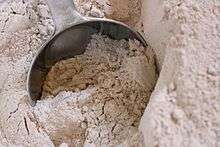Whole-wheat flour

Whole-wheat flour (in the US) or wholemeal flour (in the UK) is a powdery substance, a basic food ingredient, derived by grinding or mashing the whole grain of wheat, also known as the wheatberry. Whole-wheat flour is used in baking of breads and other baked goods, and also typically mixed with lighter "white" unbleached or bleached flours (that have been treated with flour bleaching agent(s)) to restore nutrients (especially fiber, protein, and vitamins), texture, and body to the white flours that can be lost in milling and other processing to the finished baked goods or other food(s).
White whole wheat flour
White whole-wheat flour is flour milled from hard white spring wheat,[1] rather than traditional red wheat. In the United Kingdom and India, whole-wheat flour is more commonly made from white wheat instead of red as in the United States and sold as Wholemeal Flour. The difference is that soft white wheat has a lower gluten content and also lacks the tannins and phenolic acid that red wheat contain, causing white whole wheat to appear and taste more like refined red wheat; it is whitish in color and does not taste bitter.[2]
White whole wheat has almost the same nutrient content as red whole wheat. However, soft white whole wheat has a lower gluten content and contains a lower protein content (between 9% and 11%) when compared with harder wheats like red (15–16% protein content) or golden wheat.
See also
- Wheat flour
- Whole grain
- Unifine Mill
- Graham bread an early attempt to reintroduce whole-wheat bread
- Roman Meal a whole grain baking company founded in 1912
References
External links
- Whole Wheat Bread, Mayo Clinic